Lamb Shanks are popular in many cultures/cuisines and not just in Bangladeshi cuisine. It’s a dish many people have grown up eating and adoring, but never thought of actually cooking, because it seems like an arduous task. I don’t recall eating Lamb Shanks like this as a child but I do know my dad would buy the shanks and have them cut into smaller pieces by our butcher. My mum would then make a curry out of them, the part we enjoyed the most was the prized soft centre of the marrow bone. In our family pieces of marrow bone with the soft centre were known as ‘holey meat’, although ‘holy meat’ was quite befitting too, as it really was sacred to us, even worth fighting for! I’m happy to say my children love Lamb Shanks and our favourite way to eat this is with a traditional side of Soi Fita, Bengali rice dumplings, which mop up the delicious juices.
Traditionally, cuts of meat like the shanks are cooked very slowly on the stove top, however to speed things up I’m using the help of a pressure cooker. I know not everyone owns a pressure cooker, don’t fret you can still cook this, it’ll just take you a little longer. The key to really tender lamb shanks is to slowly simmer the shanks (over a low flame) in liquid for several hours, till the tough muscles and collagen break down; between 2 – 2.5 hours is a good length of time to get the shanks tender (when cooking on the stove top without a pressure cooker). For super tender, falling off of the bone shanks, I would cook them for 2.5 – 3.5 hours in total (please note these times are estimates as I always use a pressure cooker). Whether you’re cooking on the stove top or using a pressure cooker for this, ensure there is always enough liquid in your cooking pot to prevent the meat from drying out and burning, always top up as necessary. Please follow your pressure cooker manual for instructions on how to use it, as I cannot be held responsible for negligence.
You want to tenderise the shanks before adding any spices and fat, so make sure you’re happy with the tenderness before adding those ingredients. You can experiment with the spices, seasonings and the type of fat you use; I’ve added garam masala, I often add a pinch of methi (fenugreek) seeds to this dish or sometimes Panch Phoron (Indian five spice). You could also opt for ghee (clarified butter) instead of oil or butter with a splash of cream for a creamier velvety texture to your finished curry. There are so many options and it’s entirely up to you how you want the finished dish to taste, you are the chef, so experiment!
Serves 6
You will need:
6 lamb shanks
4 onions peeled
1 stem of ginger OR 2 heaped tsp crushed ginger
5 – 6 cloves of garlic OR 2 heaped tsp crushed garlic
salt to your taste (I used about 1.5 tsp salt)
1 tsp garam masala
3/4 of a pint of water (top up as necessary, if you’re cooking in a normal pot start with 1 pint and top up as necessary)
200ml oil
a pinch of fenugreek (methi) seeds
3 – 4 bay leaves
3 – 4 cinnamon sticks
3 – 4 cardamom pods
1 tsp turmeric powder
2 tsp mixed curry powder
1 tsp kashmiri chilli powder (this gives the curry a more vibrant colour)
2 tsp cumin powder
1 tsp coriander powder
coriander for garnishing
Method:
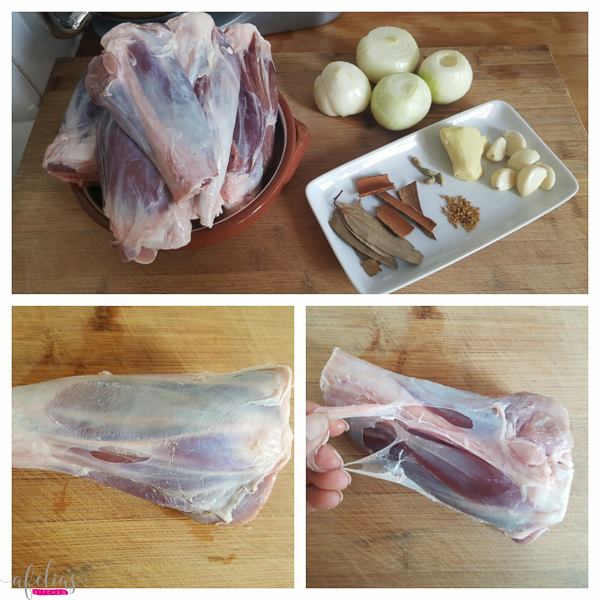
Start by removing the white coloured excess tissue using a knife, there is a lot of tissue which holds the meat together and you don’t want too much of this on your shanks.

You will find there is a lot of excess tissue that comes away from each piece. You want the colour of the meat to be visible as can be seen in the top right photo.
Wash the shanks using hot water, you will find this helps loosen any remaining excess tissue, cut any extra fibres using scissors.

Do not remove ALL the tissue as you need some to hold the shape of the shanks. After washing, leave to drain.
Chop 4 small onions and crush one stem of ginger using a pestle and mortar….
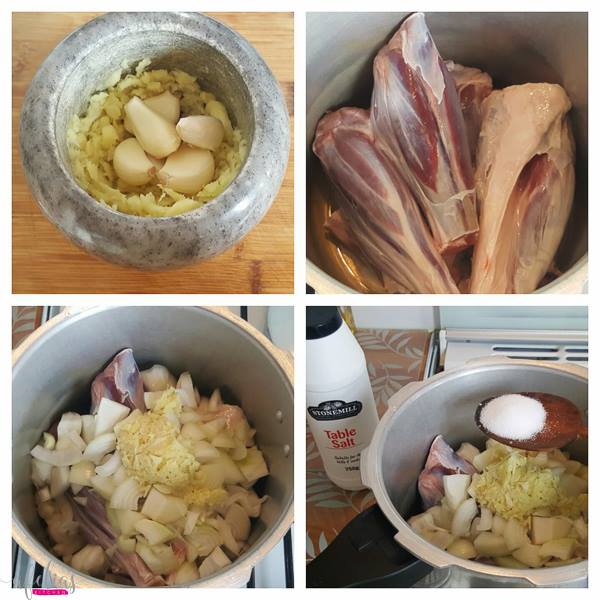
….and 5 – 6 cloves of garlic.
Place the lamb shanks in a pressure cooker, along with the chopped onions, crushed ginger and garlic, 1.5 tsp of salt (I eyeballed the amount here)….
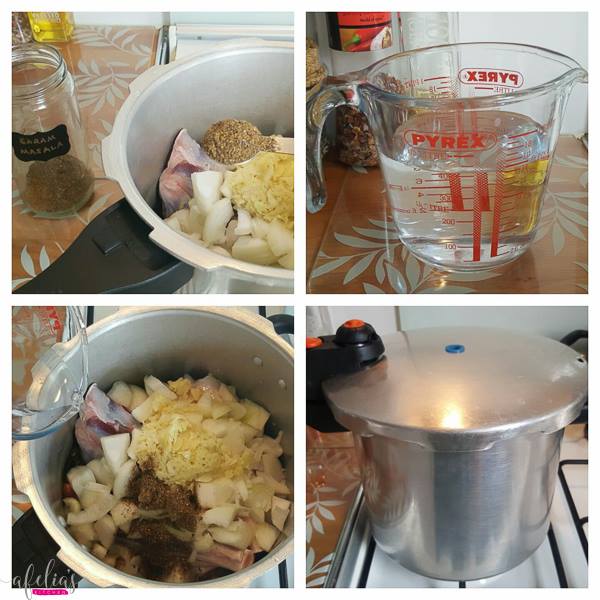
….1 tsp of garam masala and 3/4 of a pint of water. Close the lid on the pressure cooker and cook for 1 hour, checking half way through the cooking time to stir and top up with water if necessary.
A pressure cooker works a little differently to a standard pot in that you can’t just take the lid off when you please; the pressure that builds up inside the cooker has to be released first and then the lid can be removed.
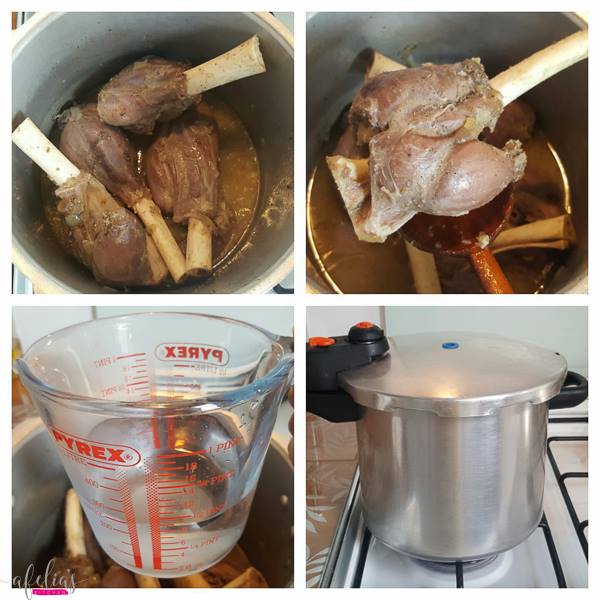
After 30 minutes check the lamb shanks (if you are using a pressure cooker) and have a feel of how firm/tender they feel. My shanks still looked tough and felt firm (top right photo) so I added more water (approximately 1/4 pint more) and cooked the shanks for a further 30 minutes (60 minutes in total).
If you are using a standard pot then you can stir and check as you go but will need a longer amount of cooking time, I would say between 1.5 – 2 hours for this stage and a further 30 minutes after adding spices and boiling. You can always gently simmer for longer if you want the shanks more tender.
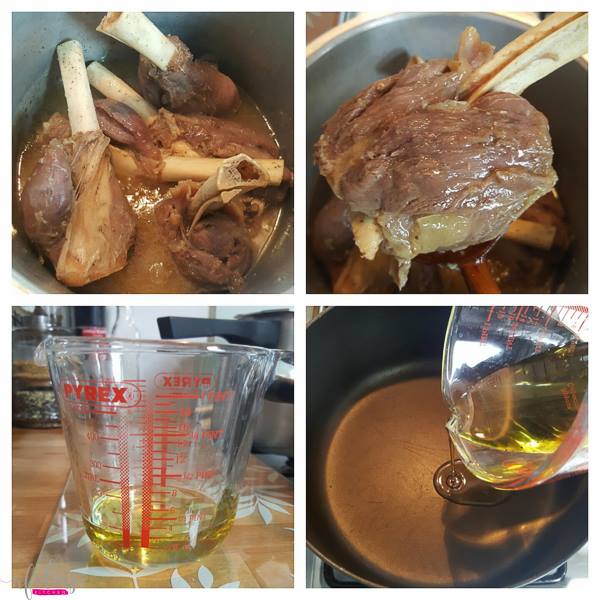
After one hour of being cooked the shanks looked like this (top right photo) and felt much softer without feeling like the meat was falling apart. My family like their meat tender but to remain on the bone, they don’t enjoy super soft meat; if you want your meat falling off of the bone, cook for longer. Don’t forget the shanks will cook for a further 25 – 30 minutes whilst frying in the spices and being boiled.
If you are not using a pressure cooker cook for a total of 2 – 2.5 hours.
For the next stage, in a large wide pot (pot needs to be wide and big to be able to mix and stir the shanks with ease) add 100ml of oil and heat.
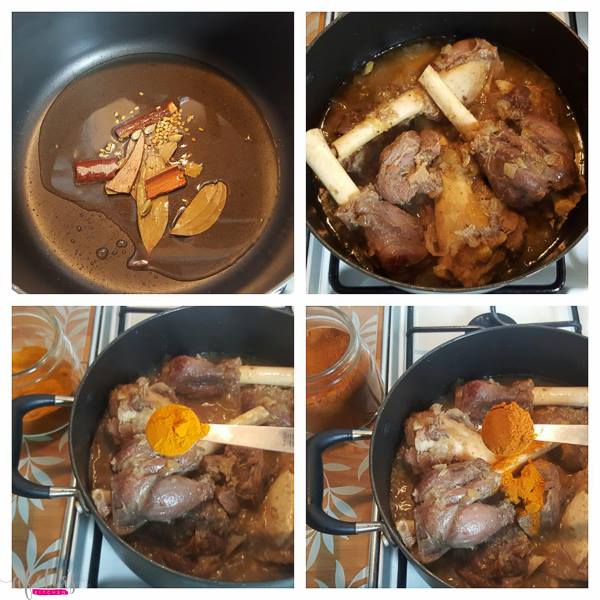
Add the whole spices; a pinch of fenugreek seeds, 3 – 4 bay leaves, 3 – 4 cinnamon sticks and 3 – 4 cardamom pods to the hot oil till the aroma is released. Next carefully transfer the contents of your pressure cooker to the wide pot, add a little more water if the contents seem dry.
If you’re using a normal pot no need to transfer, simply add the ground spices and oil.
Add 1 tsp of turmeric powder, 2 tsp of mixed curry powder….

….1 tsp chilli powder (use Kashmiri chilli powder for a more vibrant colour) 2 tsp cumin powder and 1 tsp coriander powder. Mix the spices with the shanks and cook uncovered for 10 – 15 minutes to fry the shanks in spices and oil, stir occasionally to prevent burning and help break down the onions further.

After frying the shanks in spices for 10 – 15 minutes you need to add some water depending on how much gravy you want in your curry, having more gravy is suitable if you’re serving this with Soi Fita or Chappatis. I added coriander at this stage thinking I didn’t want any more gravy as there was a fair amount of fluid already but I decided I did want more, I then added about 1/4 of a pint of water, you may add more if you prefer. Don’t add the coriander until you’re happy with the consistency of the gravy.
Cover the pot after adding the water and allow the shanks to boil over a medium – high flame for about 10 – 15 minutes. You can always gently simmer the Lamb Shanks for longer over a low flame if for any reason the shanks aren’t as tender as you would like.
Finally check for salt and garnish with coriander just before removing from the heat.
Your finished dish should look glorious and ready to devour!
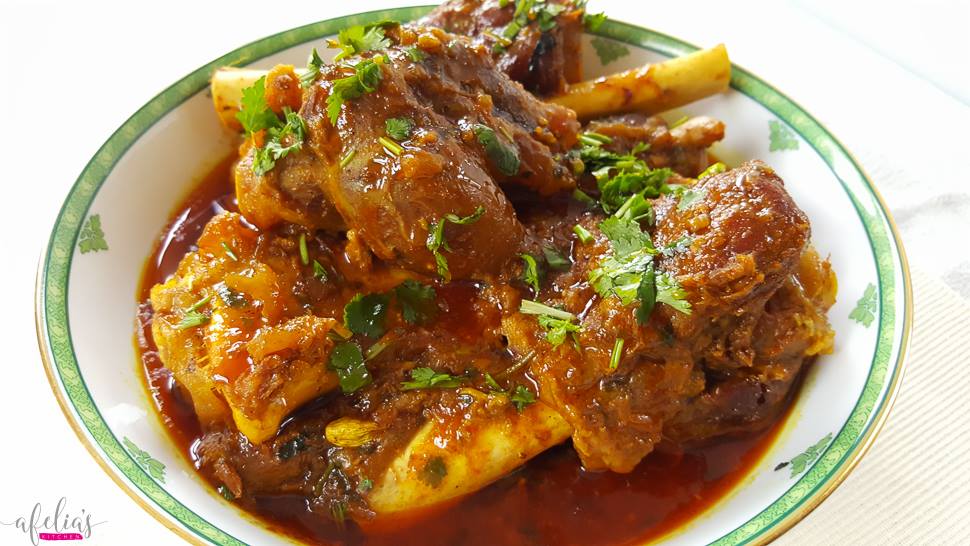
Serve your Lamb Shanks with a traditional Bengali side of Soi Pita (Rice Flour Dumplings), Chappatis or with a flat bread to soak up the delicious juices.
Bon Appetit!
- 6 lamb shanks
- 4 onions peeled
- 1 stem of ginger OR 2 heaped tsp crushed ginger
- 5 - 6 cloves of garlic OR 2 heaped tsp crushed garlic
- salt to your taste (I used about 1.5 tsp salt)
- 1 tsp garam masala
- ¾ of a pint of water (top up as necessary, if you're cooking in a normal pot start with 1 pint and top up as necessary)
- 200ml oil
- a pinch of fenugreek (methi) seeds
- 3 - 4 bay leaves
- 3 - 4 cinnamon sticks
- 3 - 4 cardamom pods
- 1 tsp turmeric powder
- 2 tsp mixed curry powder
- 1 tsp kashmiri chilli powder (this gives the curry a more vibrant colour)
- 2 tsp cumin powder
- 1 tsp coriander powder
- coriander for garnishing
- Start by removing the white coloured excess tissue using a knife, there is a lot of tissue which holds the meat together and you don't want too much of this on your shanks.
- You will find there is a lot of excess tissue that comes away from each piece. You want the colour of the meat to be visible as can be seen in the top right photo.
- Wash the shanks using hot water, you will find this helps loosen any remaining excess tissue, cut any extra fibres using scissors.
- Do not remove ALL the tissue as you need some to hold the shape of the shanks. After washing, leave to drain.
- Chop 4 small onions and crush one stem of ginger using a pestle and mortar....
- and 5 - 6 cloves of garlic.
- Place the lamb shanks in a pressure cooker, along with the chopped onions, crushed ginger and garlic, 1.5 tsp of salt (I eyeballed the amount here)....
- tsp of garam masala and ¾ of a pint of water. Close the lid on the pressure cooker and cook for 1 hour, checking half way through the cooking time to stir and top up with water if necessary.
- A pressure cooker works a little differently to a standard pot in that you can't just take the lid off when you please; the pressure that builds up inside the cooker has to be released first and then the lid can be removed.
- After 30 minutes check the lamb shanks (if you are using a pressure cooker) and have a feel of how firm/tender they feel. My shanks still looked tough and felt firm (top right photo) so I added more water (approximately ¼ pint more) and cooked the shanks for a further 30 minutes (60 minutes in total).
- If you are using a standard pot then you can stir and check as you go but will need a longer amount of cooking time, I would say between 1.5 - 2 hours for this stage and a further 30 minutes after adding spices and boiling. You can always gently simmer for longer if you want the shanks more tender.
- After one hour of being cooked the shanks looked like this (top right photo) and felt much softer without feeling like the meat was falling apart. My family like their meat tender but to remain on the bone, they don't enjoy super soft meat; if you want your meat falling off of the bone, cook for longer. Don't forget the shanks will cook for a further 25 - 30 minutes whilst frying in the spices and being boiled.
- If you are not using a pressure cooker cook for a total of 2 - 2.5 hours.
- For the next stage, in a large wide pot (pot needs to be wide and big to be able to mix and stir the shanks with ease) add 100ml of oil and heat.
- Add the whole spices; a pinch of fenugreek seeds, 3 - 4 bay leaves, 3 - 4 cinnamon sticks and 3 - 4 cardamom pods to the hot oil till the aroma is released. Next carefully transfer the contents of your pressure cooker to the wide pot, add a little more water if the contents seem dry.
- If you're using a normal pot no need to transfer, simply add the ground spices and oil.
- Add 1 tsp of turmeric powder, 2 tsp of mixed curry powder....
- tsp chilli powder (use Kashmiri chilli powder for a more vibrant colour) 2 tsp cumin powder and 1 tsp coriander powder. Mix the spices with the shanks and cook uncovered for 10 - 15 minutes to fry the shanks in spices and oil, stir occasionally to prevent burning and help break down the onions further.
- After frying the shanks in spices for 10 - 15 minutes you need to add some water depending on how much gravy you want in your curry, having more gravy is suitable if you're serving this with Soi Fita or Chappatis. I added coriander at this stage thinking I didn't want any more gravy as there was a fair amount of fluid already but I decided I did want more, I then added about ¼ of a pint of water, you may add more if you prefer. Don't add the coriander until you're happy with the consistency of the gravy.
- Cover the pot after adding the water and allow the shanks to boil over a medium - high flame for about 10 - 15 minutes. You can always gently simmer the Lamb Shanks for longer over a low flame if for any reason the shanks aren't as tender as you would like.
- Finally check for salt and garnish with coriander just before removing from the heat.
- Your finished dish should look glorious and ready to devour!
If you like the recipe please share with friends and family, also follow me on Facebook and Instagram. Questions? Leave a comment below or message me on Facebook.




Reshma
My asian butcher does not understand lamb shanks. Is there another name for this part? He keeps showing me chops.
afelia’s kitchen
Maybe try showing him a photo of the shanks so he understands what you’re referring to?
Rahela Khatun
Can u do a recipe for soy feetah like a easy to follow and make too. Thank you so much.
afelia’s kitchen
I already have shared a recipe for Soi Fita, search using the search tool to find it. x